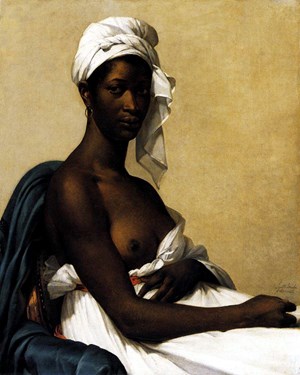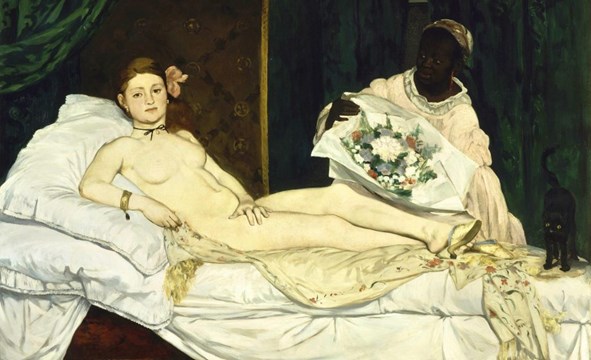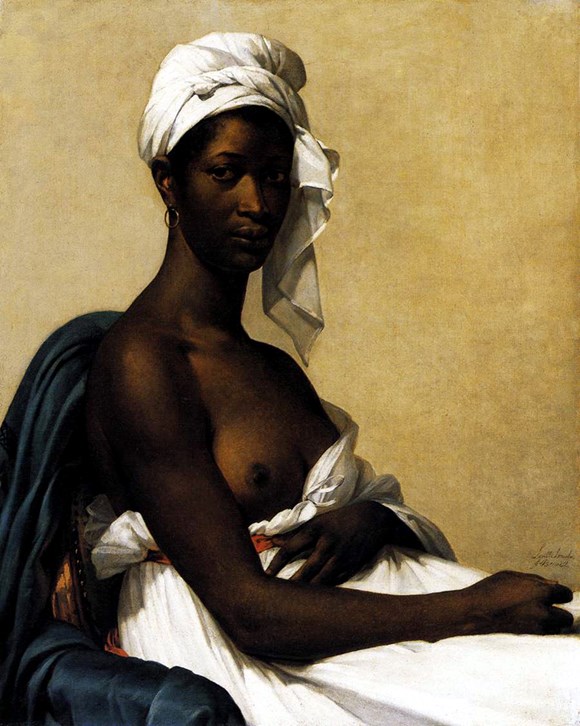
Paris’ Musee d'Orsay opened ‘Black Models: from Gericault to Metisse.’ Running through July 21st, the exhibition is in the second leg of its installation after debuting at Columbia University’s Wallach Art Gallery last year under the title ‘Posing Modernity: The Black Model from Manet and Matisse to Today.’
Image: 'Olympia', temporarily titled 'Laure', Édouard Manet, 1863. Courtesy Wikimedia Commons.
Paris’ Musee d'Orsay opened ‘Black Models: from Gericault to Metisse.’ Running through July 21st, the exhibition is in the second leg of its installation after debuting at Columbia University’s Wallach Art Gallery last year under the title ‘Posing Modernity: The Black Model from Manet and Matisse to Today.’ The multi-disciplinary exhibition, as the titles reference, puts the spotlight on the black figures ever-present in the backgrounds of many paintings from early modern art. To further honour the purpose of the exhibition, the Musée d’Orsay has renamed Édouard Manet’s renowned 1863 painting Olympia. For the length of the exhibition, the painting will be titled Laure, the name of the black maid who stands in the background of the painting. The painting integral to the exhibition, not only because it has served as a cornerstone in Western art history but because it has served at the exhibition’s inspiration.

'Olympia', temporarily titled 'Laure', Édouard Manet, 1863. Courtesy Wikimedia Commons.
‘People have told me, “It’s not that I didn’t see the black maid in the painting, I just didn’t know what to say about her”,’ Denise Murrell, one of the exhibition’s curators, toldThe Guardian. ‘I always felt she is presented in a more stronger light than maids usually are, and I wondered what could be said about her, even though art history said very little.’ Renaming the painting, though, has shifted the focus away from the reclining, nude, white woman who, since its debut at the Salon, has sparked intrigue and controversy. The painting’s temporary name is ‘emblematic,’ said Murrell in a statement, as it asks viewers, and art historians to reconsider the black figures that are often overlooked or deduced; it asks us to see them as ‘the individuals they were.’
In addition to Laure, the museum has also temporarily renamed Portrait of a Black Woman, a painting created by Marie-Guillemine Benoist in 1800. For the exhibition, the painting will be called Portrait of Madeleine referencing the woman who sat for the painting. ‘For more than 200 years there has never been an investigation to discover who she was—something that was recorded at the time,’ said Murrell.

‘Portrait of a Black Woman’, temporarily titled ‘Portrait of Madeleine, Marie-Guillemine Benoist, 1800. Courtesy Wikimedia Commons.
By looking specifically at the models, ‘Black models: from Géricault to Matisse’ will examine the relationship between the artist and those they painted, sculpted, or photographed. It aims to bring together ‘the history of art and the history of ideas,’ according to the museum's statement about the exhibition, as it explores social, political, aesthetic, and racial issues. The exhibition will include works by Théodore Géricault, Charles Cordier, Jean-Baptiste Carpeaux, Edouard Manet, Paul Cézanne Henri Matisse, Nadar, Carjat, and more.
While the New York edition of the exhibition was solely curated by Murrell, she worked alongside Cécile Debray, director of the Musée de l’Orangerie; Stéphane Guégan, scientific advisor to the president of the Musée d’Orsay and Orangerie; and Orsay curators Isolde Pludermacher and Edouard Papet to curate the Paris show.

ArtDependence Magazine is an international magazine covering all spheres of contemporary art, as well as modern and classical art.
ArtDependence features the latest art news, highlighting interviews with today’s most influential artists, galleries, curators, collectors, fair directors and individuals at the axis of the arts.
The magazine also covers series of articles and reviews on critical art events, new publications and other foremost happenings in the art world.
If you would like to submit events or editorial content to ArtDependence Magazine, please feel free to reach the magazine via the contact page.